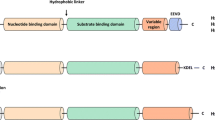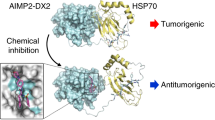Abstract
Heat shock protein 70 (HSP70) and HSP70-peptide complexes (HSP70-PCs) have been implicated in the pathogenesis of multiple tumors in humans and have been experimentally shown to increase the proliferation of cell lines derived from hepatocellular carcinoma. The goal of this study was to elucidate the molecular mechanisms through which extracellular HSP70/HSP70-PCs stimulate the proliferation of hepatocellular carcinoma (HCC). The molecular mechanisms of HSP70/HSP70-PC action were studied in the human hepatocellular carcinoma cell lines HepG2 and Huh-7, as well as tumor tissue collected from patients with HCC (n = 95). We found that HSP70/HSP70-PCs can stimulate the proliferation of HepG2 cells and that this effect is blocked by knocking down TLR2 and TLR4 expression by RNA interference. A physical interaction between HSP70/HSP70-PCs and TLR2/4 was established using co-immunoprecipitation and pull-down assays. Pharmacological inhibition of different branches of the MAPK intracellular signaling pathway indicated that the extracellular HSP70/HSP70-PC effect was mediated by the JNK1/2 signaling pathway within the cell. We also studied TLR2 and TLR expression at the protein and messenger RNA (mRNA) level in tumor and non-tumor tissue in patients with HCC (n = 95), finding that TLR2 and 4 are increased in HCC tumor tissue and that the expression of TLR2 correlates with clinicopathologic features of HCC. Our data conclusively demonstrates that extracellular HSP70/HSP70-PCs can promote the proliferation of HCC cells through activation of TLR2 and TLR4 and subsequent activation of the intracellular JNK1/2/MAPK signaling pathway.





Similar content being viewed by others
References
Torre LA et al. Global cancer statistics, 2012. CA Cancer J Clin. 2015;65(2):87–108.
Chen JG, Zhang SW. Liver cancer epidemic in China: past, present and future. Semin Cancer Biol. 2011;21(1):59–69.
Maeda S. NF-kappaB, JNK, and TLR signaling pathways in hepatocarcinogenesis. Gastroenterol Res Pract. 2010;2010:367694.
Duffy DJ, Millane RC, Frank U. A heat shock protein and Wnt signaling crosstalk during axial patterning and stem cell proliferation. Dev Biol. 2012;362(2):271–81.
Kang Y et al. Prognostic significance of heat shock protein 70 expression in early gastric carcinoma. Korean J Pathol. 2013;47(3):219–26.
Gogate SS et al. Tonicity enhancer binding protein (TonEBP) and hypoxia-inducible factor (HIF) coordinate heat shock protein 70 (Hsp70) expression in hypoxic nucleus pulposus cells: role of Hsp70 in HIF-1alpha degradation. J Bone Miner Res. 2012;27(5):1106–17.
Horibe T et al. Synergetic cytotoxic activity toward breast cancer cells enhanced by the combination of Antp-TPR hybrid peptide targeting Hsp90 and Hsp70-targeted peptide. BMC Cancer. 2014;14:615.
Schmitt E et al. Intracellular and extracellular functions of heat shock proteins: repercussions in cancer therapy. J Leukoc Biol. 2007;81(1):15–27.
Wu FH et al. Extracellular HSPA1A promotes the growth of hepatocarcinoma by augmenting tumor cell proliferation and apoptosis-resistance. Cancer Lett. 2012;317(2):157–64.
Asea A et al. Novel signal transduction pathway utilized by extracellular HSP70: role of toll-like receptor (TLR) 2 and TLR4. J Biol Chem. 2002;277(17):15028–34.
Murphy MB, Medvedev AE. Long noncoding RNAs as regulators of Toll-like receptor signaling and innate immunity. J Leukoc Biol. 2016.
Chen L, Yu J. Modulation of Toll-like receptor signaling in innate immunity by natural products. Int Immunopharmacol. 2016.
Tsai SY et al. DAMP molecule S100 A9 acts as a molecular pattern to enhance inflammation during influenza a virus infection: role of DDX21-TRIF-TLR4-MyD88 pathway. PLoS Pathog. 2014;10(1):e1003848.
Henrick BM et al. HIV-1 structural proteins serve as PAMPs for TLR2 heterodimers significantly increasing infection and innate immune activation. Front Immunol. 2015;6:426.
Leake I. Hepatocellular carcinoma. Treatment potential of targeting Toll-like receptors in HCC. Nat Rev. Gastroenterol Hepatol. 2014;11(9):518.
Chen R et al. Cancers take their Toll—the function and regulation of toll-like receptors in cancer cells. Oncogene. 2008;27(2):225–33.
Yue P et al. Des-gamma-carboxyl prothrombin induces matrix metalloproteinase activity in hepatocellular carcinoma cells by involving the ERK1/2 MAPK signalling pathway. Eur J Cancer. 2011;47(7):1115–24.
Huang Y, et al. MAPK/ERK2 phosphorylates ERG at serine 283 in leukemic cells and promotes stem cell signatures and cell proliferation. Leukemia. 2016.
Kamiyama M, Naguro I, Ichijo H. In vivo gene manipulation reveals the impact of stress-responsive MAPK pathways on tumor progression. Cancer Sci. 2015;106(7):785–96.
Peroval MY et al. A critical role for MAPK signalling pathways in the transcriptional regulation of toll like receptors. PLoS One. 2013;8(2):e51243.
Wu TT et al. GATA-2 transduces LPS-induced il-1beta gene expression in macrophages via a toll-like receptor 4/MD88/MAPK-dependent mechanism. PLoS One. 2013;8(8):e72404.
Shimura T, Fukumoto M, Kunugita N. The role of cyclin D1 in response to long-term exposure to ionizing radiation. Cell Cycle. 2013;12(17):2738–43.
Zhang Y et al. A systematic investigation based on microRNA-mediated gene regulatory network reveals that dysregulation of microRNA-19a/cyclin D1 axis confers an oncogenic potential and a worse prognosis in human hepatocellular carcinoma. RNA Biol. 2015;12(6):643–57.
Qiu C et al. GM-CSF induces cyclin D1 expression and proliferation of endothelial progenitor cells via PI3K and MAPK signaling. Cell Physiol Biochem. 2014;33(3):784–95.
Gao Y et al. A new purification method for enhancing the immunogenicity of heat shock protein 70-peptide complexes. Oncol Rep. 2012;28(6):1977–83.
Li H et al. Expression of HSP70 and JNK-related proteins in human liver cancer: potential effects on clinical outcome. Dig Liver Dis. 2007;39(7):663–70.
Blachere NE et al. Heat shock protein-peptide complexes, reconstituted in vitro, elicit peptide-specific cytotoxic T lymphocyte response and tumor immunity. J Exp Med. 1997;186(8):1315–22.
Casaburi I et al. Chenodeoxycholic acid through a TGR5-dependent CREB signaling activation enhances cyclin D1 expression and promotes human endometrial cancer cell proliferation. Cell Cycle. 2012;11(14):2699–710.
Kiang JG, Tsokos GC. Heat shock protein 70 kDa: molecular biology, biochemistry, and physiology. Pharmacol Ther. 1998;80(2):183–201.
Cho HS et al. Enhanced HSP70 lysine methylation promotes proliferation of cancer cells through activation of Aurora kinase B. Nat Commun. 2012;3:1072.
Gong W et al. Invasion potential of H22 hepatocarcinoma cells is increased by HMGB1-induced tumor NF-kappaB signaling via initiation of HSP70. Oncol Rep. 2013;30(3):1249–56.
Monma H et al. The HSP70 and autophagy inhibitor pifithrin-mu enhances the antitumor effects of TRAIL on human pancreatic cancer. Mol Cancer Ther. 2013;12(4):341–51.
Mambula SS, Calderwood SK. Heat shock protein 70 is secreted from tumor cells by a nonclassical pathway involving lysosomal endosomes. J Immunol. 2006;177(11):7849–57.
Bohnhorst J et al. Toll-like receptors mediate proliferation and survival of multiple myeloma cells. Leukemia. 2006;20(6):1138–44.
Gandhi A, Moorthy B, Ghose R. Drug disposition in pathophysiological conditions. Curr Drug Metab. 2012;13(9):1327–44.
Lee CH, Wu CL, Shiau AL. Toll-like receptor 4 signaling promotes tumor growth. J Immunother. 2010;33(1):73–82.
Yu L, Wang L, Chen S. Dual character of toll-like receptor signaling: pro-tumorigenic effects and anti-tumor functions. Biochim Biophys Acta. 2013;1835(2):144–54.
Jain RK. Normalizing tumor microenvironment to treat cancer: bench to bedside to biomarkers. J Clin Oncol. 2013;31(17):2205–18.
Kim JY et al. Sulforaphane suppresses vascular adhesion molecule-1 expression in TNF-alpha-stimulated mouse vascular smooth muscle cells: involvement of the MAPK, NF-kappaB and AP-1 signaling pathways. Vasc Pharmacol. 2012;56(3–4):131–41.
Acknowledgments
This study is supported by the National Natural Science Foundation of China (No. 81071955) and the Scientific Research from Educational Department of Liaoning Province, China (No. 2013021088).
Author information
Authors and Affiliations
Corresponding author
Ethics declarations
The Institutional Review Board of the Shengjing Hospital of China Medical University approved the use of human tissue samples for this project. All patients gave their informed and written consent for the use of the clinical specimens for research.
Conflicts of interest
None
Electronic supplementary material
Table S1
(DOC 27 kb)
Rights and permissions
About this article
Cite this article
Zhe, Y., Li, Y., Liu, D. et al. Extracellular HSP70-peptide complexes promote the proliferation of hepatocellular carcinoma cells via TLR2/4/JNK1/2MAPK pathway. Tumor Biol. 37, 13951–13959 (2016). https://doi.org/10.1007/s13277-016-5189-5
Received:
Accepted:
Published:
Issue Date:
DOI: https://doi.org/10.1007/s13277-016-5189-5




